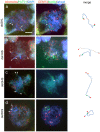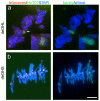The subtelomeric region is important for chromosome recognition and pairing during meiosis
- PMID: 25270583
- PMCID: PMC4180820
- DOI: 10.1038/srep06488
The subtelomeric region is important for chromosome recognition and pairing during meiosis
Abstract
The process of meiosis results in the formation of haploid daughter cells, each of which inherit a half of the diploid parental cells' genetic material. The ordered association of homologues (identical chromosomes) is a critical prerequisite for a successful outcome of meiosis. Homologue recognition and pairing are initiated at the chromosome ends, which comprise the telomere dominated by generic repetitive sequences, and the adjacent subtelomeric region, which harbours chromosome-specific sequences. In many organisms telomeres are responsible for bringing the ends of the chromosomes close together during early meiosis, but little is known regarding the role of the subtelomeric region sequence during meiosis. Here, the observation of homologue pairing between a pair of Hordeum chilense chromosomes lacking the subtelomeric region on one chromosome arm indicates that the subtelomeric region is important for the process of homologous chromosome recognition and pairing.
Figures




References
-
- Ronceret A. & Pawlowski W. P. Chromosome dynamics in meiotic prophase I in plants. Cytogenet. Genome Res. 129, 173-183 (2010). - PubMed
-
- Page S. L. & Hawley R. S. Chromosome Choreography: The Meiotic Ballet. Science 301, 785-789 (2003). - PubMed
-
- Bass H. W. et al. Evidence for the coincident initiation of homolog pairing and synapsis during the telomere-clustering (bouquet) stage of meiotic prophase. J. Cell Sci. 113, 1033-1042 (2000). - PubMed
-
- Zickler D. & Kleckner N. The leptotene-zygotene transition of meiosis. Annu. Rev. Genet. 32, 619-697 (1998). - PubMed
-
- Prieto P., Shaw P. & Moore G. Homologous recognition during meiosis is associated with a change in chromatin conformation. Nat. Cell Biol. 6, 906-908 (2004). - PubMed
Publication types
MeSH terms
LinkOut - more resources
Full Text Sources
Other Literature Sources

